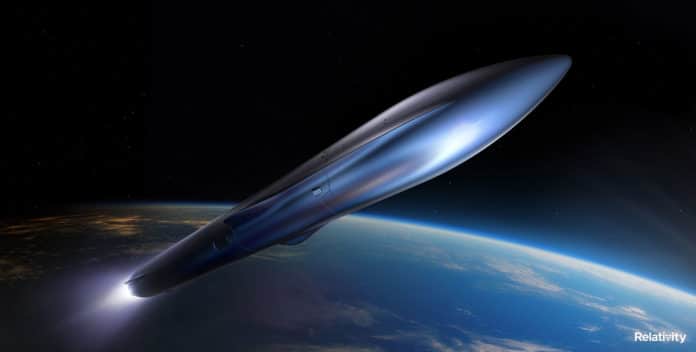Relativity Space has revealed its plans for Terran R, its fully reusable, entirely 3D-printed launch vehicle. The new reusable rocket, whose capabilities are comparable to those of the Falcon 9, could become operational within three years, and its construction process will be revolutionary.
Relativity Space describes Terran R as a two-stage rocket that stands 216-foot-tall with a 16-foot diameter and a 5-meter payload fairing. It will be entirely reusable and capable of launching 20,000 kg to low Earth orbit (LEO) that is very similar in capacity to the famous SpaceX Falcon 9.
The 3D-printed launch vehicle can be created from raw materials in less than 60 days by the same printers as Terran 1. The rocket has unique aerodynamic features and geometries that wouldn’t be possible with traditional production methods. The company’s proprietary 3D printing process utilizes software-driven manufacturing, exotic materials, and unique design geometries that are not possible in traditional manufacturing.
Terran R will be powered by seven 3D-printed Aeon R rocket engines capable of 302,000 lb. thrust each, while its upper stage houses one Aeon Vac engine. It will be manufactured using a mix of 3D printing, artificial intelligence, and autonomous robotics to print the structures and engines.
Starting in 2024, Terran R will launch from Launch Complex 16, the company’s site at Cape Canaveral, where Terran 1 is also set to launch this year. Combined with the ability to launch 20X more payload than Terran 1, Terran R provides both government and commercial customers affordable access to space in LEO and beyond. Terran R was developed to accommodate the growing demand for large constellation launch services and the company’s growing pipeline of commercial interest.
“From our founding days in Y Combinator just five years ago, we planned on 3D printing Terran 1 and then Terran R – a 20X larger fully reusable rocket – on our Factory of the Future platform,” said Tim Ellis, CEO, and co-founder of Relativity. “Today, we are one step closer to this goal. Together with our first rocket, Terran 1, our second product, Terran R, will continue to take advantage of Relativity’s disruptive approach to 3D printing – reduced part count, improved speed of innovation, flexibility, and reliability – to bring to market the next generation of launch vehicles.“
“Relativity was founded with the mission to 3D print entire rockets and build humanity’s industrial base on Mars. We were inspired to make this vision a reality and believe there need to be dozens to hundreds of companies working to build humanity’s multi-planetary future on Mars. Scalable, autonomous 3D printing is inevitably required to thrive on Mars, and Terran R is the second product step in a long-term journey Relativity is planning ahead.“
Terran R also represents a large leap towards Relativity’s mission to build humanity’s multi-planetary future, eventually offering customers a point-to-point space freighter capable of missions between Earth, Moon, and Mars.
